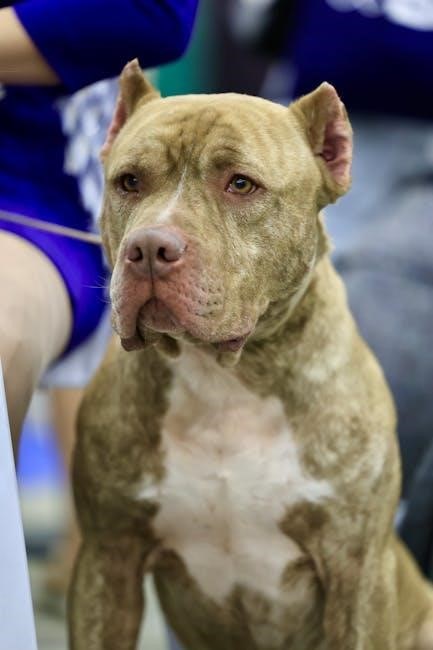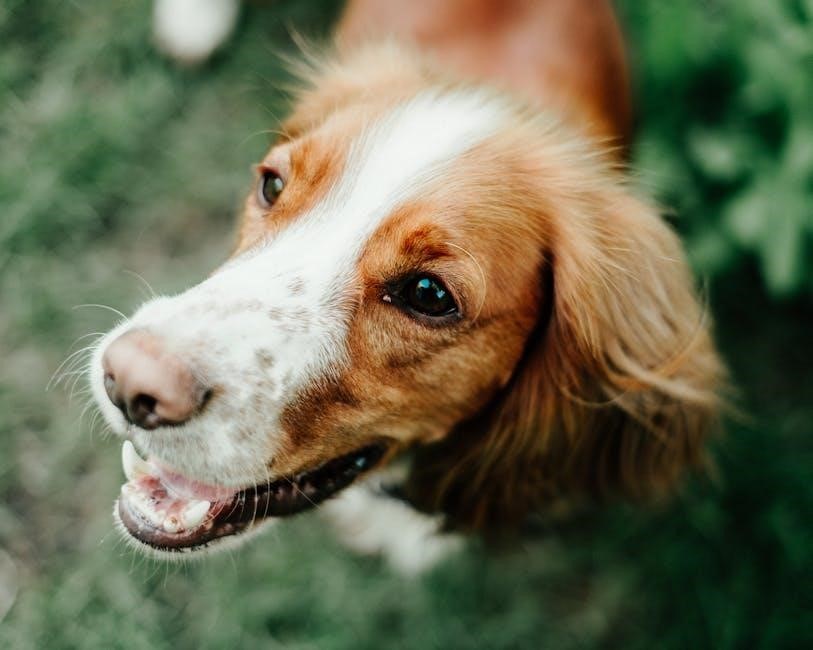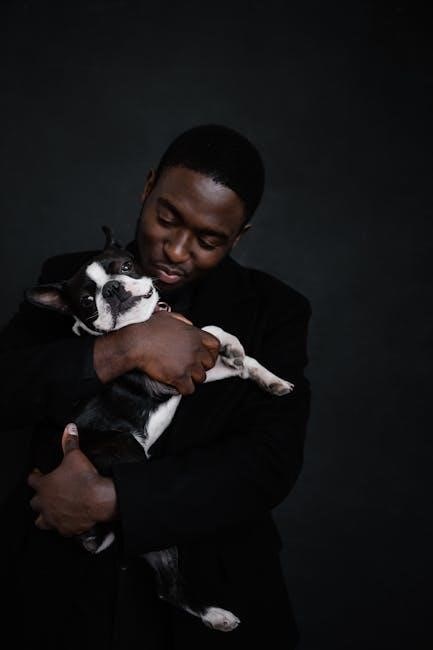Dog muzzles are essential tools for preventing bites and managing behaviors. Available in types like basket or soft‚ they ensure safety while allowing panting. Proper sizing is crucial for effectiveness and comfort‚ making accurate measurements key to selecting the right muzzle for your dog.
1.1 What is a Dog Muzzle?
A dog muzzle is a device that fits over a dog’s snout to prevent biting or nipping. Made from materials like nylon‚ leather‚ or silicone‚ muzzles come in styles such as basket‚ soft‚ or nylon. They allow dogs to pant and drink while restricting jaw movement. Muzzles are used for training‚ vet visits‚ or managing aggression. They ensure safety for people and animals while enabling dogs to perform natural behaviors. Proper fit is essential for comfort and effectiveness‚ making them a humane tool for various situations‚ including socialization or medical procedures. They are not punitive but practical solutions for dog owners.
1.2 Importance of Proper Muzzle Sizing
Proper muzzle sizing is crucial for your dog’s comfort‚ safety‚ and effectiveness. A well-fitted muzzle prevents discomfort‚ stress‚ or even injury. If too tight‚ it can restrict breathing or panting‚ essential for temperature regulation. If too loose‚ it may not serve its purpose. Correct sizing ensures the muzzle stays in place‚ allowing your dog to eat‚ drink‚ and pant while providing necessary control. Improper sizing can lead to behavioral issues or escape attempts. Always measure accurately and choose a muzzle that balances security with your dog’s well-being. Proper fit ensures the muzzle is both functional and humane‚ making it a reliable training or safety tool.

Understanding Your Dog’s Snout Shape
Snout shape varies by breed and size‚ affecting muzzle fit. Measure length and circumference accurately. Consider your dog’s breed and head type to ensure proper sizing and comfort.
2.1 Measuring Your Dog’s Snout Length
To measure your dog’s snout length‚ use a flexible tape measure. Start at the tip of the nose and extend it to the base‚ just below the eyes. Ensure the tape is snug but not tight; This measurement is critical for selecting the correct muzzle size‚ as it ensures proper fit and comfort. Accurate snout length helps prevent the muzzle from being too tight or too loose‚ which could compromise safety or comfort for your dog;
2.2 Measuring Your Dog’s Snout Circumference
To measure your dog’s snout circumference‚ wrap a flexible tape measure around the widest part of the snout‚ typically just below the eyes and nostrils. Ensure the tape is snug but not tight‚ forming a circle around the snout. This measurement is vital for selecting a muzzle that fits comfortably and allows for proper panting. Accurate circumference ensures the muzzle isn’t too restrictive or loose‚ promoting both safety and comfort for your dog. Combine this with snout length for a precise fit.
2.3 Considering Your Dog’s Breed and Head Type
While measuring is crucial‚ your dog’s breed and head type also influence muzzle fit. Certain breeds‚ like Bulldogs or Pugs‚ may require muzzles accommodating shorter‚ flatter snouts. Longer-nosed breeds‚ such as Greyhounds‚ need muzzles with adequate length. Head shape varies‚ so muzzles should align with your dog’s unique anatomy. For example‚ brachycephalic breeds need extra room for comfort. Using breed-specific sizing charts can help‚ but always verify against your dog’s actual measurements‚ as individual variations exist. Ensuring the muzzle matches your dog’s head type guarantees both comfort and functionality.
Choosing the Right Muzzle Type
Selecting the right muzzle type ensures comfort and meets specific needs. Basket muzzles allow panting‚ soft muzzles are lightweight‚ and nylon muzzles offer durability for training or behavioral issues.
3.1 Types of Muzzles (Basket‚ Soft‚ Nylon‚ etc.)
Various muzzle types cater to different needs. Basket muzzles‚ made from durable materials‚ allow panting and are ideal for aggressive dogs. Soft muzzles‚ often fabric or mesh‚ are lightweight and suitable for short-term use. Nylon muzzles offer a balance of durability and flexibility. There are also leather muzzles for strength and style. Each type ensures safety while considering the dog’s comfort and specific requirements‚ making them suitable for training‚ vet visits‚ or behavior modification. Choosing the right material and design is crucial for effectiveness and your dog’s well-being.
3.2 Selecting a Muzzle Based on Your Dog’s Needs
Choosing the right muzzle involves assessing your dog’s behavior‚ lifestyle‚ and comfort. For aggressive dogs‚ a sturdy basket muzzle is ideal‚ while soft or nylon muzzles suit calm dogs. Consider the purpose: training‚ vet visits‚ or daily use. Ensure the muzzle allows panting and comfort. Measure accurately to avoid restriction. Match the muzzle type to your dog’s snout shape and size. Proper fit ensures safety and effectiveness‚ making it a reliable tool for managing behavior while prioritizing your dog’s well-being.

How to Measure Your Dog for a Muzzle
Measure your dog’s snout length from the tip to the base and circumference at the widest point. Use a flexible tape measure for accuracy‚ ensuring a comfortable fit. Consult a sizing chart to match measurements with the appropriate muzzle size‚ considering your dog’s breed and muzzle type for optimal comfort and safety.
4.1 Step-by-Step Measurement Guide
Start by gently holding your dog’s head steady. Use a flexible tape measure to record the snout length from the tip to just below the eyes. Next‚ measure the snout circumference at its widest point‚ ensuring the tape isn’t too tight or loose. For accuracy‚ take two measurements: one while your dog is calm and another during slight movement. Note your dog’s breed-specific features‚ as some muzzles are tailored for certain head shapes. Record these measurements and compare them to the sizing chart provided by the muzzle manufacturer to ensure the best fit for comfort and functionality.
4.2 Using a Sizing Chart
Once you’ve measured your dog’s snout length and circumference‚ consult the sizing chart provided by the muzzle manufacturer. Align your measurements with the chart to determine the correct size. Most charts categorize muzzles by size ranges‚ such as small‚ medium‚ or large. Ensure the muzzle fits snugly but not too tightly‚ allowing your dog to pant and eat treats. If your measurements fall between sizes‚ consider going one size up for comfort. Referencing a sizing chart ensures accuracy and helps avoid common mistakes like choosing a muzzle that’s too restrictive or too loose.
Fitting the Muzzle Correctly
Adjust the muzzle straps to ensure a snug yet comfortable fit. Ensure proper breathability and ability to pant. Monitor your dog for signs of discomfort or restriction.

5.1 Adjusting the Muzzle Straps
Properly adjusting the muzzle straps ensures a secure‚ comfortable fit. Start by placing the muzzle on your dog‚ then tighten the straps gradually. Ensure the muzzle allows enough room for your dog to pant and eat treats. Avoid overtightening‚ as this can cause discomfort or restrict breathing. For breeds with unique snout shapes‚ adjust straps to accommodate their specific features. Regularly check the fit to prevent chafing or irritation. Adjustments should prioritize your dog’s comfort while maintaining the muzzle’s effectiveness. Consult a professional if unsure about the fit or if your dog shows signs of distress. Proper adjustment ensures safety and well-being.
5.2 Ensuring Comfort and Safety
Ensuring your dog’s comfort and safety while wearing a muzzle is crucial. Choose a muzzle made from breathable‚ non-irritating materials‚ such as mesh or soft nylon. The muzzle should allow your dog to pant‚ drink‚ and eat small treats. Avoid muzzles that restrict movement or cause chafing. Regularly inspect the muzzle for wear and tear‚ and ensure it fits properly to prevent skin irritation. Never leave a muzzled dog unattended‚ as this could lead to distress or accidental injury. Always prioritize your dog’s well-being‚ balancing safety with their physical and emotional comfort. A well-fitted muzzle promotes a positive experience for your dog.
Training Your Dog to Accept the Muzzle
Introduce the muzzle gradually‚ using treats and praise to create a positive association. Start with short sessions‚ allowing your dog to become comfortable at their own pace.
6.1 Introducing the Muzzle Gradually
Begin by letting your dog explore the muzzle at their own pace. Place it near their food or toys to spark curiosity. Gently touch their snout with the muzzle while offering treats. Gradually increase exposure‚ starting with short sessions without securing it. Once comfortable‚ secure the muzzle briefly‚ rewarding calm behavior. Extend the duration slowly‚ ensuring your dog remains relaxed. Consistency and patience are key to building trust and acceptance. This method helps reduce anxiety and makes the muzzle a positive experience for your dog.
6.2 Positive Reinforcement Techniques
Positive reinforcement is key to helping your dog accept the muzzle. Start by offering treats or toys to create a positive association. Reward your dog for calm behavior when the muzzle is near or on. Use verbal praise and gentle touch to build confidence. Avoid forcing the muzzle‚ as this can cause anxiety. Instead‚ let your dog set the pace‚ allowing them to explore and accept the muzzle willingly. Consistency and patience are essential; Over time‚ your dog will learn to view the muzzle as a non-threatening tool‚ making the process stress-free for both of you.

Common Mistakes to Avoid
Avoid using a muzzle as a permanent solution or relying on incorrect sizing. These mistakes can lead to discomfort‚ anxiety‚ or ineffective behavior management. Always address root causes with professional help and proper training techniques.
7.1 Incorrect Sizing

Incorrect sizing is a common mistake that can lead to discomfort‚ restricted breathing‚ or anxiety for your dog. A muzzle that is too tight may cause skin irritation or difficulty panting‚ while one that is too loose may not serve its purpose effectively. Always measure your dog’s snout length and circumference accurately using a flexible tape measure. Consult a sizing chart specific to the muzzle type you’re considering‚ as sizes can vary between brands. Avoid assuming size based on breed alone‚ as individual variations are common. If unsure‚ consider using a sizing quiz or seeking professional advice to ensure the best fit.
7.2 Using a Muzzle as a Permanent Solution
Using a muzzle as a permanent solution is not advisable‚ as it can lead to discomfort‚ anxiety‚ and restricted behavior in dogs. Muzzles are designed for temporary use to manage specific situations‚ such as vet visits or training. Relying on a muzzle long-term does not address the underlying causes of aggression or fear. Instead‚ it’s essential to work with professional trainers or behaviorists to resolve these issues. Proper training and behavior modification are more effective and humane solutions. A muzzle should never replace proactive‚ force-free approaches to helping your dog thrive.
Proper sizing‚ choosing the right muzzle type‚ and gradual training are key for a safe‚ comfortable fit. Always prioritize your dog’s well-being and safety with patience and care.
8;1 Summary of Key Points
A proper dog muzzle size guide ensures comfort‚ safety‚ and effectiveness. Accurate measurements of snout length and circumference are essential for the right fit. Consider your dog’s breed‚ head type‚ and specific needs when selecting a muzzle. Use a sizing chart to avoid incorrect sizing‚ which can lead to discomfort or ineffectiveness. Introduce the muzzle gradually‚ using positive reinforcement to help your dog accept it. Avoid using muzzles as permanent solutions; address behavioral issues with professional help. Proper fitting and training ensure your dog can pant‚ eat‚ and stay comfortable while wearing the muzzle.
8.2 Final Recommendations
Ensure your dog’s muzzle fits comfortably by following sizing guides and measuring accurately. Choose a muzzle type that suits your dog’s needs‚ such as basket or soft muzzles. Gradually introduce the muzzle using positive reinforcement to build trust. Avoid using muzzles as permanent solutions for behavioral issues; consult professionals for training. Regularly check the fit to accommodate growth or changes. Always prioritize your dog’s comfort and safety‚ allowing them to pant and eat while muzzled. Proper fitting and training ensure a positive experience for both you and your dog.